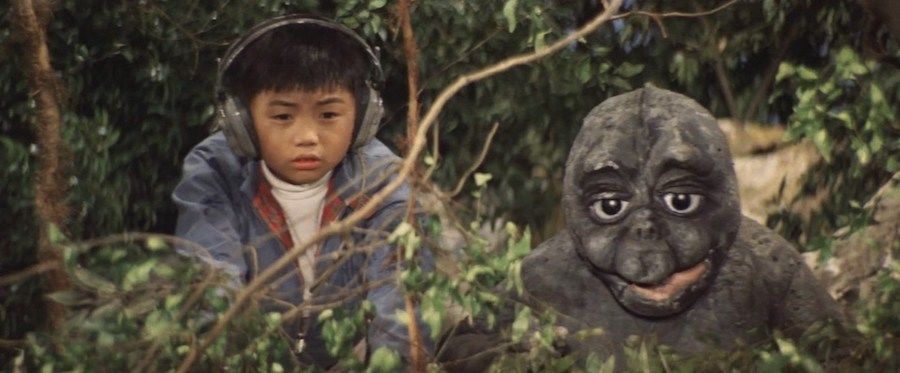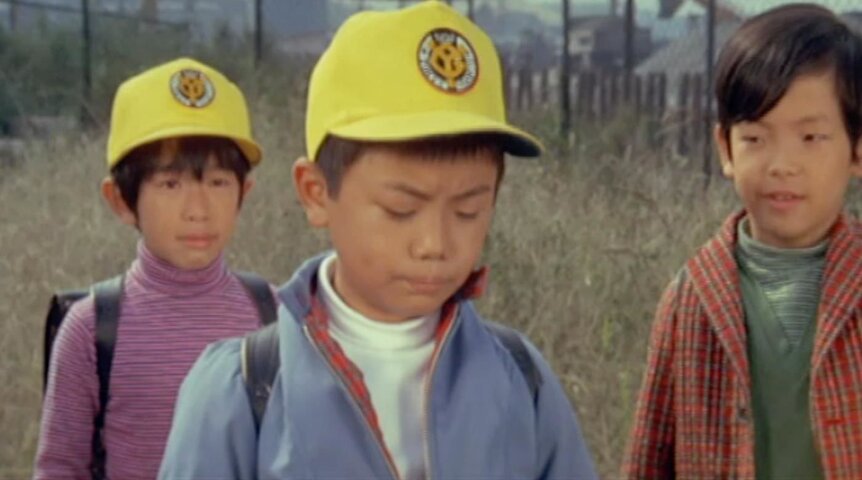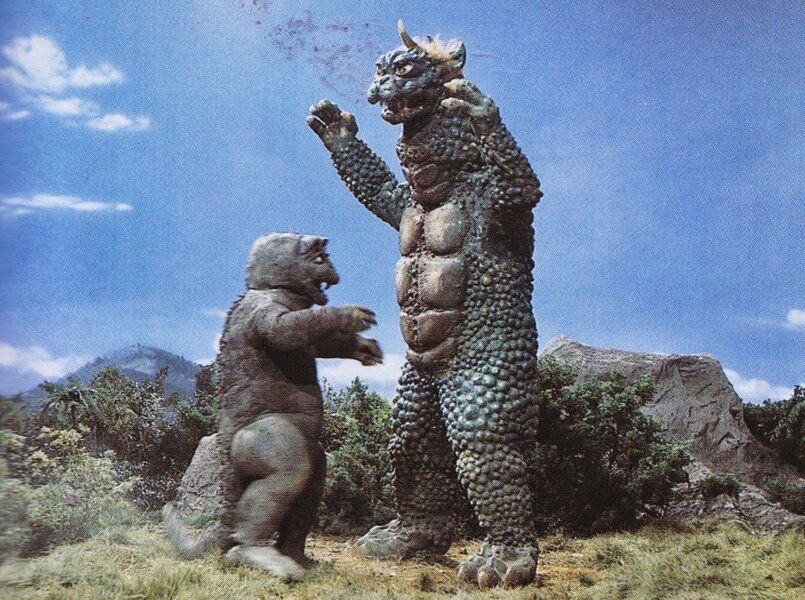Create a free profile to get unlimited access to exclusive videos, sweepstakes, and more!
In defense of Godzilla's Revenge, the most unfairly attacked Godzilla movie of all

After Ishiro Honda's original 1954 Godzilla became a tremendous success at the Japanese box office, selling well over nine million tickets and ranking as one of the ten most successful domestic features of the year, studio executive Iwao Mori instructed the staff at Toho to "make another one." From these very simple instructions came Godzilla Raids Again (1955), a hastily made sequel which, despite its rushed production values, garnered profits not far beneath that of its predecessor and indicated the opening of a very lucrative market for Japanese movie monsters.
Honda didn't direct that one, but his science fiction output soon became prolific. By the time the 1960s rolled around, his oeuvre became relegated almost exclusively to movies about monsters, aliens, and mutant humans. (Of the eighteen motion pictures he directed in the '60s, only two did not revolve around sci-fi elements.) This became somewhat exhausting for him, as he loved to dabble in different genres, but as a company man, he carried out the assignments handed to him by Toho; and the international appeal of science fiction — coupled with the continually shrinking status of the Japanese film industry — gave him few opportunities to do anything else.
There was one movie in the late 1960s, however, that offered him a balance of genres and a place to explore human characters in a more in-depth and intimate way. All Monsters Attack (1969), better known stateside as Godzilla's Revenge, was a film that featured numerous special effects sequences but, more than anything, represented a return to "everyday life" storytelling.
The movie gets a lot of guff from Godzilla fans, but as it turns 50 years old, it deserves a significant second look.
Set in downtown Kawasaki, Godzilla's Revenge begins with groups of children walking home from school. As shown in an opening montage, they reside in a city swamped with air pollution, dirty rivers, and dilapidated buildings; the streets are crammed with incessant bumper-to-bumper traffic. Along the way, we're introduced to our young protagonist, Ichiro (Tomonori Yazaki), a child who is infatuated with movie monsters, is regularly picked on by the other kids, and comes home every day to an empty house, as his parents are both working long hours to make ends meet.
Ichiro's father (played by that wonderful actor Kenji Sahara) is saving money to one day move his family to a better neighborhood, but such a day is long into the future: even with the protracted work schedules he and his wife endure, they can barely afford their tiny, cramped apartment. The father's similarly worried about his son's shy nature and lack of friends, and not at all excited by the fact that he spends most of his after-school time alone, but there's not much he can do about it at the moment.
Right away, with this wonderfully detailed opening, Honda offers a vivid glimpse into the era in which this film was made and tackles not one but several of the socioeconomic tribulations being experienced by Japanese society at the time. In the late 1960s, Japan was in the midst of its "Economic Miracle," developing the second largest economy in the world (behind the United States), but it had its downsides. Industrialization was running rampant in the country, polluting many urban environments, and numerous cities were hit by an upsurge in retail prices. That often meant families had to survive on dual incomes and bring up their children in miniscule housing units.
As shown in the film, children were often the first to return home (Ichiro picks up his latchkey from a neighbor), with parents continually slaving away for their meager paychecks. And when not walking home, the youngsters fish from the pollutant-infested rivers and play with junk on the ground. Hardly an ideal environment to grow up in (a colleague of the boy's father also expresses concern that Ichiro might be coming down with asthma, due to the smog hanging over Kawasaki).
One detail that often goes uncommented on by western reviewers are the yellow caps worn by most of the children in the film. As Honda biographer Steve Ryfle told me in an interview in 2017, yellow caps were not only a common apparel for Japanese kids at the time, they were also a means of increasing safety. The idea was that the bright yellow color would make the hats — and the kids wearing them — more noticeable to drivers and thus reduce the odds of kids being hit by cars when they crossed the street or walked/played near busy highways (remember the congested traffic seen in the picture's opening). Honda doesn't draw attention to the yellow hats, but their inclusion nonetheless makes for a subtle reflection of another social issue of late '60s Japan. (Yellow caps also appeared in other Japanese films of the time, including Nagisa Oshima's Boy, released just a few months before Godzilla's Revenge.)
In all of this, we can see Godzilla's Revenge as quite idiosyncratic for its franchise. It is the one Godzilla film that is, for all intents and purposes, not a monster movie or even a work of science fiction. Godzilla and other monsters appear in the film, sure, but only in Ichiro's imagination and as elements of pop culture. Our protagonist has a Bullmark Godzilla figure in his closet, among his other toys; and the only adult in the movie who seems well-versed in Godzilla is a kindly toymaker, someone whose profession stipulates an understanding of what children enjoy. All the other adults, by contrast, seem clueless about Minilla, the son of Godzilla.
Instead of another destruction-packed spectacle, the picture focuses on life in one of Japan's toughest socioeconomic chapters, with an ordinary person at the center of the narrative.
Continuing on that notion is the characterization of our protagonist. In contrast to the children of the Daiei Gamera series, Ichiro is presented not as a precocious smart-aleck, but rather as an average, everyday kid. He's a fun-loving elementary student who enjoys toys; he has an active imagination; he wants acceptance from the other children and to be cared for by his parents; and, above all else, he wants to play and enjoy his young life. Because, again, he's a regular kid, just like those who would've watched this movie back in 1969 and those who've watched it in the decades since.
Even children who didn't grow up in poverty-stricken conditions can identify with Ichiro's struggles: issues such as bullying are, unfortunately, still prevalent today, and the desire for friendship is something all children can associate with. With this film, Honda delivers one of his most fully drawn protagonists; and the performance of the part by Tomonori Yazaki is utterly wonderful, perhaps the single most natural piece of acting by a child actor in the Godzilla series.
But most clever is how Honda and screenwriter Shinichi Sekizawa combine everything described above with the film's other main plot thread: the recurring dream sequences in which Ichiro imagines himself wandering the jungles of Monster Island and befriending Minilla. These sequences don't simply provide an excuse to show some special effects and slap Godzilla's name on the title; they derive from, relate to, and even influence our protagonist's character arc.
In Ichiro's dreams, Minilla's dealing with bullies of his own. In his case, he's tormented by a fellow Monster Island inhabitant called Gabara (not coincidentally named after one of the kids who regularly bullies Ichiro). Gabara has no interest in harming Minilla for "animalistic" reasons: it's purely for pleasure. Although he can discharge electricity through his hands, he mostly pushes the smaller monster down again and again until Minilla runs away, enjoying a good chuckle before marching back into the jungle, the torment to continue another day.
And just as Minilla eventually learns to stand up for himself, so does Ichiro develop the courage to face his own tormentors. When kidnapped by a pair of bank robbers, the boy uses strategy to outwit and escape them. When faced by his bully —the real Gabara — on his way to school, he stands his ground and defends himself after Gabara makes the first move. (He doesn't actively pick a fight with him as is so often misreported.)
Through his active imagination, stemming from his love for pop culture, Ichiro gains his courage and independence. A much more dynamic relationship between a child and a monster — even an imaginary one — than what was seen in the original Gamera movies, in which the monster-loving kids predominately stood off to the side, cheering Gamera on.
In addition to its very child-centric story, Godzilla's Revenge is often scorned by genre fans for the extensive use of stock footage in its dream sequences. And to be fair, one can fairly argue this is one of the film's shortcomings. Granted, stock footage had become something of a tradition in Toho productions by the late 1960s, but the use of it here is particularly jarring.
Whereas past movies would, for the most part, just grab a shot or two to supplement the new footage, Godzilla's Revenge recycles whole sequences from Godzilla vs. the Sea Monster (1966) and Son of Godzilla (1967). After a while, it does become a tad noticeable, especially when Godzilla's appearance shapeshifts from one moment to the next (as the filmmakers toggle between footage from different movies featuring different Godzilla suits).
But even on this level, Godzilla's Revenge is owed a certain degree of admiration, for it does exhibit a much more resourceful and imaginative use of stock footage than other movies of the time using the same technique (i.e., the Gamera movies). For example, 1968's Gamera vs. Viras resorted to simply playing long chunks of stock footage in merciless succession; at one point, the film's villains watch a fifteen-minute-long effects reel with the flimsy excuse of "examining Gamera's past."
By contrast, Godzilla's Revenge merely takes the highlights of past special effects productions, cuts them down to something manageable, and balances them out with inserted shots of Ichiro and Minilla watching from the cover of the jungle. And at times, the stock footage battle scenes directly affect them, so they are smartly utilized.
When Ebirah hits the ocean with his pincer, a cascade of water comes pouring on top of the boy and his reptilian friend. When Minilla tries to intervene in Godzilla's battle with Kumonga by puffing a smoke ring at the huge spider (establishing Minilla's inability to breathe atomic fire — something which remains relevant through the narrative), he then has to run from an incoming blast of sticky webbing. So while the use of stock footage in Godzilla's Revenge can be distracting at times, the filmmakers at least incorporate it feasibly and relate it to the new footage accompanying it.
When screenwriter Shinichi Sekizawa pitched the concept of Godzilla's Revenge to the producers at Toho, it was with the selling point of using stock footage from past kaiju movies as a cost-saving measure. It was also a project that contextually represented something new and lasting for the franchise. As the author of this piece touched on in another article last year, 1968's Destroy All Monsters was the final entry in the original cycle of Godzilla films made for mainstream audiences (read: adults as well as children).
Starting with Godzilla's Revenge and lasting all the way through the 1970s, Godzilla films would make their premieres at the Toho Champion Festival, a triannual event designed to entertain children, playing in kiddie matinees. The adult audience for Godzilla had been steadily shrinking for years, and this film, made for children, marked the first time the series would be designed with younger audiences first and foremost in mind.
But what ultimately came out of all this was something so much more valuable than an economic technique or marketing trend. Examined on its own terms, Godzilla's Revenge is a rather sweet little movie and one of Ishiro Honda's most earnest efforts in the Godzilla series. A poignant gem dealing with serious issues — many of them still relevant today — providing food for thought for adults while entertaining its target audience.
The views and opinions expressed in this article are the author's and do not necessarily reflect those of SYFY WIRE, SYFY, or NBCUniversal.




























